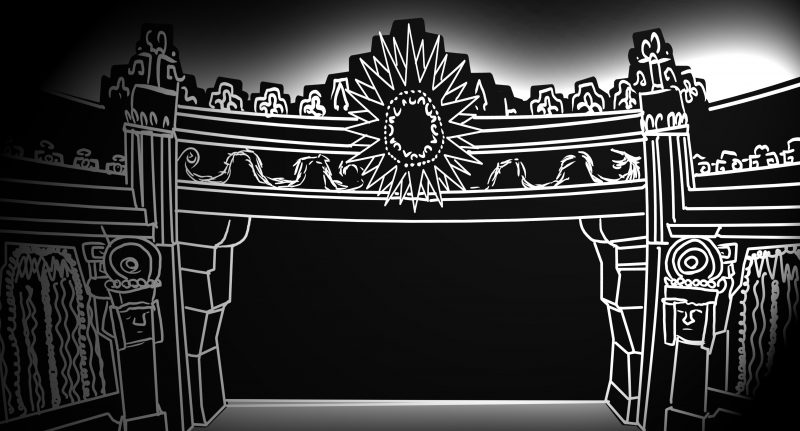Over the course of three issues, the Trinitonian will run articles as part of a series exploring different types of performance venues in San Antonio. The series highlights three types of venues: a DIY space, a medium-sized venue and a larger concert hall. Throughout the series, we interview performing artists, members of the venues’ administrations and members of the audiences.
This week’s edition focuses on a large concert hall, the Aztec Theatre.
There’s something uniquely San Antonian about listening to rock music under a giant 1929 chandelier, surrounded by ancient Mesoamerican stylings.
The Aztec Theatre was built in 1926 and is as well-respected for its history and ancient Mesoamerican architectural style as it is for the bands that play there.
The venue’s character, paired with the commercial security of a national corporation — it is owned and operated by Live Nation — make the Aztec Theatre a key venue for both growing and well-established acts.
For Libby Day, the marketing manager at the Aztec, the theater’s key attraction is its individuality in San Antonio’s event market.
“The space that the Aztec fills is really special because out of the three large theaters — Aztec, Majestic and Tobin — we’re the only building that has a GA [General Admission] floor,” Day said. “Our building is super flexible. We do all genres, whether it be blues, jazz, metal, rap, soul, hip-hop, comedy. It kind of runs the gamut.”
The Aztec’s size is another aspect which Day says differentiates it from other venues in the city.
“We get a lot of artists who come through this building who are too big for Paper Tiger and who want to do a standing GA show, so we’re their only option,” Day said. “We cater to artists who are either in a place in their career where they’re growing, like Highly Suspect, or artists like Marilyn Manson, where he’s doing a huge underplay.”
Eric Huerta, a fan of Highly Suspect, stood in line for hours to see the Oct. 11 concert at the San Antonio venue.
“They’ve caught people’s attention, and that’s probably why they’re playing here,” Huerta said. “Basically, it’s just good for musicians to be able to move to bigger venues where they won’t necessarily sell out. That’s great for the band.”
The size of the venue and the national acts that perform in it aren’t the Aztec Theatre’s only attractions. The building’s interior design hasn’t changed since its creation in 1926, and due to the Aztec’s status on the National Register of Historic Places, the management must be careful to stay true to the original stylings. Mesoamerican-inspired masks peer out at the 55-foot stage from between columns and imitation stonework, offering a distinct performance environment.
For Trinity junior Carlotta de Bellis, who has attended three concerts at the Aztec this semester, the building itself has played an influential role in her experience at each show.
“It’s interesting how it incorporates elements of Aztec architecture in a city as culturally rich as San Antonio,” de Bellis said. “It’s in one of the most prominent locations, and the theater itself kind of elevates the performance.”
Brian Fiegelman, the production manager at the Aztec, manages the sound, lighting and day-of-show duties of the theater. Fiegelman agreed that the Aztec’s character and its production capabilities create a perfect venue for San Antonio.
“There’s an experience level that you can’t have at a DIY or club show that we can do,” Fiegelman said. “Before the Aztec, San Antonio had this hole where you couldn’t see this intimate show with an emerging artist or a huge act doing an underplay. This is the venue that every town needs.”
In addition to the written pieces featured in the Trinitonian, we are creating three supplemental videos which serve as mini-documentaries about each space. Though the story and the video can each stand alone, we encourage you to read and watch both components to get the best version of the story.







